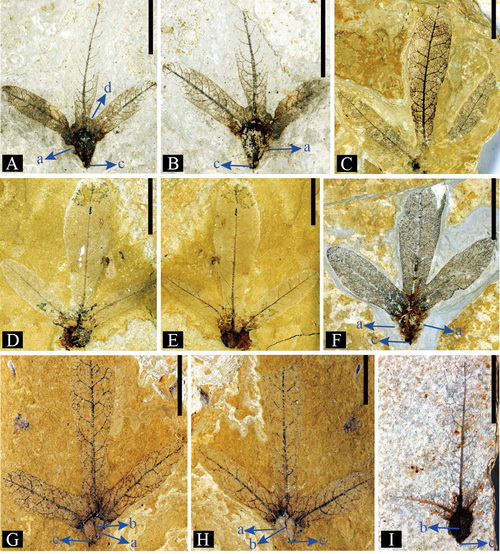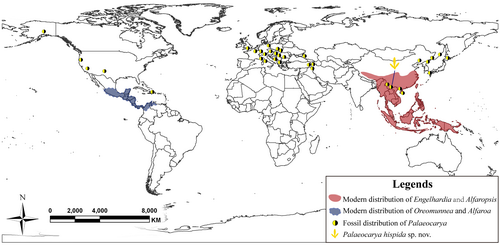Palaeocarya has been emended based on the uncertainty of assigning fossil winged fruits to the extant genera Engelhardia, Alfaropsis, or Oreomunnea (Engelhardieae: Juglandaceae). Fossil fruits of Palaeocarya (Juglandaceae) are described from late Miocene sediments of southeastern Yunnan, China. The fruits present a tri-lobed wing consisting of an intact oblong-ovate middle lobe and two lateral lobes. The lobes are apically obovate, and have pinnate venation. The middle lobe is thicker at the base and gradually tapers to the apex. The nutlet, located at the base of the winged fruit, is round and hispid, and is subdivided by a septum into two compartments. Based on extensive morphological comparisons to previously .
Thus, we describe the fossils as a new species, Palaeocarya hispida sp. nov. Fossil records indicate that Palaeocarya had a much wider distribution in the past than the current distributions of their modern relatives in Engelhardia, Alfaropsis, Oreomunnea, and Alfaroa . Because a younger fossil representative of Palaeocarya, Palaeocarya olsoni, was reported from the Miocene of western North America, we propose that the wide distribution of Palaeocarya and relatively narrow distributions of close relatives, Engelhardia, Alfaropsis, and Oreomunnea, might be associated with a stepwise cooling and a major ice sheet expansion in the Antarctic and Arctic from the late middle Miocene to early Pliocene. In particular, the climatic oscillations during the Quaternary, such as the last glacial maximum, might have led to a decrease in the geographic distribution of Engelhardieae.
This study was completed by Hong-Hu Meng (a Ph D candidate in Xishuangbanna Tropical Botanical Garden) and was guided be supervisor, Prof. Zhe-Kun Zhou. The paper was titled "Late Miocene Palaeocarya (Engelhardieae: Juglandaceae) from Southwest China and its biogeographic implications" and published in Journal of Systematics and Evolution.

Fig. 1 Fossil fruits of Palaeocarya hispida from Wenshan, Yunnan, China.

Fig.2 Detailed characteristics of Palaeocarya hispida.

Fig. 3 Map showing modern and fossil fruit distribution range of Engelhardieae.



